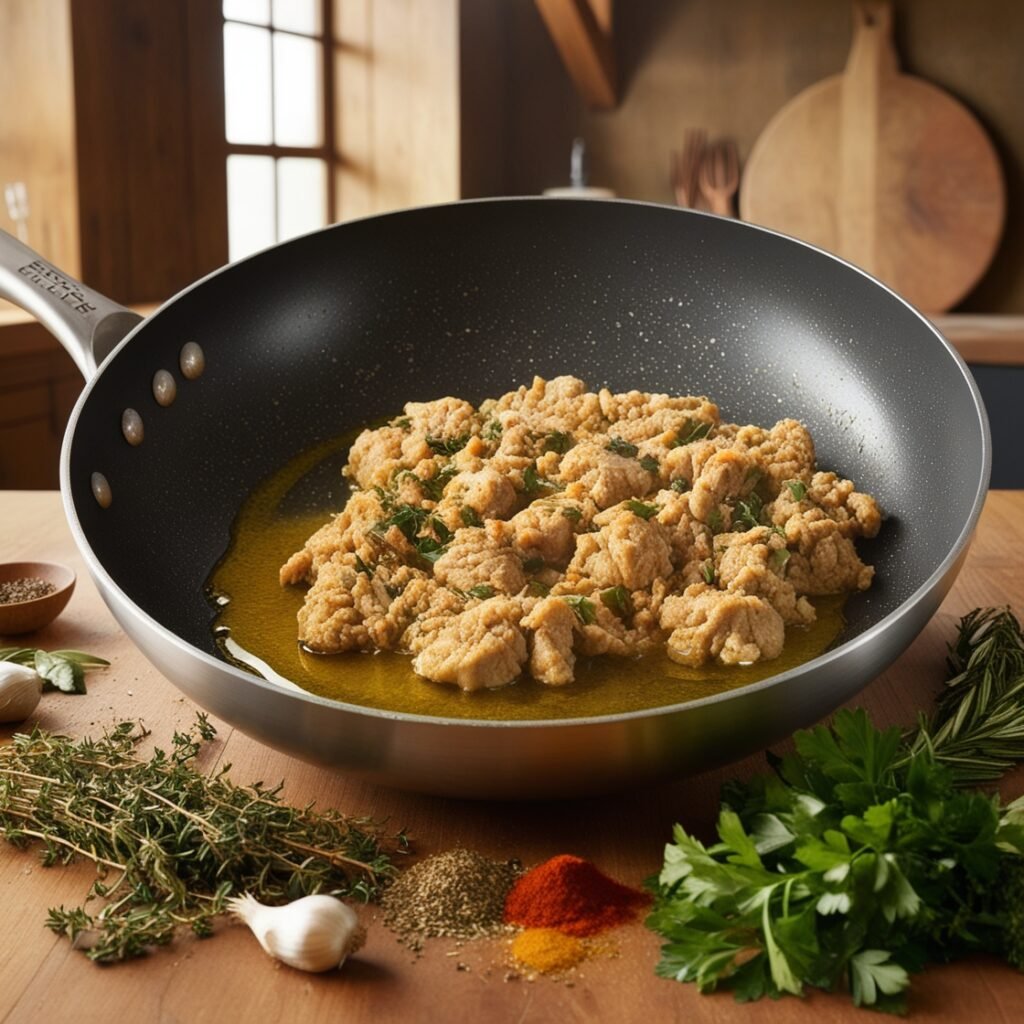Table of Contents
Introduction
In the quest for healthy eating, many wonder: which is healthier? ground chicken or ground turkey? These two lean proteins are popular choices for their versatility, nutritional benefits, and ability to fit into almost any diet. Understanding their differences can help you make a more informed choice for your health and lifestyle.
However, the debate persists: which is healthier—ground chicken or ground turkey? The answer isn’t as straightforward as it might seem, as both have unique nutritional profiles, benefits, and culinary uses.
This article explores the differences between these two types of ground meat, examining their nutritional value, health benefits, cooking versatility, and even their environmental impact. By the end, you’ll have the knowledge to choose the best option for your dietary needs and lifestyle.
Nutritional Comparison of Ground Chicken and Ground Turkey
Comparing which is healthier, ground chicken or ground turkey comes down to factors like protein content, fat levels, and calorie count. While both are excellent sources of lean protein, small differences in macronutrients, vitamins, and minerals can influence your decision.
Protein Content
Protein is essential for muscle repair, tissue growth, and overall energy. Both ground chicken and turkey provide high amounts of protein, but there are subtle differences:
- Ground Turkey: Offers approximately 28 grams of protein per 100 grams, making it slightly higher in protein than chicken. It’s a great choice for those focused on muscle-building or recovery after workouts.
- Ground Chicken: Contains around 25 grams of protein per 100 grams, slightly less than turkey but still a substantial amount for meeting daily protein needs.
Whether you choose chicken or turkey, both will support your protein goals effectively.
Fat Levels
The fat content in ground poultry depends largely on the cut of meat used (lean or regular).
- Ground Turkey: Lean turkey is particularly low in fat, containing 1-3 grams of fat per 100 grams. Regular cuts may contain more fat, ranging from 7-10 grams.
- Ground Chicken: Similarly, lean ground chicken contains 2-5 grams of fat, while regular cuts can go up to 10-12 grams of fat per serving.
In general, lean ground turkey is the better choice for those looking to minimize fat intake.
Calorie Count
Calories are a critical factor when managing weight or maintaining a calorie-controlled diet.
- Ground Turkey: Lean turkey has about 120 calories per 100 grams, while fattier cuts can rise to 180 calories.
- Ground Chicken: Lean chicken contains slightly more calories at 130 per 100 grams, and regular cuts can range from 170 to 200 calories.
While the difference is small, ground turkey tends to be the leaner and lower-calorie option overall.
Vitamins and Minerals
Both ground chicken and turkey are rich in essential vitamins and minerals:
- Ground Turkey: Offers higher levels of selenium, which supports the immune system, and vitamin B6, which aids brain function.
- Ground Chicken: Contains slightly more niacin (vitamin B3), which helps improve metabolism and energy production.
In terms of micronutrients, the differences are minor, and both meats contribute well to a nutrient-rich diet.
Health Benefits of Ground Chicken and Ground Turkey

Both ground chicken and ground turkey have unique health benefits that make them ideal for various dietary goals. Their nutrient composition, impact on weight management, and heart health potential are some of the key factors to consider.
Heart Health
Reducing saturated fat intake is vital for maintaining good cardiovascular health. Both ground chicken and turkey offer lean options that are heart-friendly, but turkey typically has the edge:
- Lean Ground Turkey: Contains less saturated fat compared to ground chicken, making it an excellent choice for lowering cholesterol levels and supporting a heart-healthy diet.
- Lean Ground Chicken: Still a good option, but slightly higher in saturated fat depending on the cut.
Opting for lean ground turkey can help reduce the risk of heart disease while maintaining a balanced fat intake.
Weight Management
Ground chicken and turkey both fit seamlessly into weight-loss and weight-maintenance plans due to their high protein and low-calorie content. Protein helps increase satiety, making you feel full longer, which can reduce overall calorie intake.
- Ground Turkey: Its slightly lower calorie count and leaner fat profile make it an ideal option for calorie-controlled diets.
- Ground Chicken: Still an effective choice, offering a slightly richer flavor that some might prefer when dieting.
Building Muscle: Which Is Healthier—Ground Chicken or Ground Turkey?
Protein is the cornerstone of muscle building, and both ground turkey and chicken are rich in this macronutrient. However, turkey’s higher protein content makes it the preferred choice for athletes and those looking to build or maintain muscle mass.
Additionally, both meats contain essential amino acids that aid muscle repair and recovery.
Versatility for Special Diets
Both ground chicken and turkey are versatile enough to suit a variety of dietary needs:
- Low-Carb and Keto Diets: Both are excellent low-carb options, with turkey being a leaner choice for keto dieters who want to balance protein and fat intake.
- Gluten-Free Diets: Naturally gluten-free, both are safe choices for those with gluten sensitivities or celiac disease.
Culinary Uses and Versatility

One of the reasons ground chicken and turkey are so popular is their incredible versatility in the kitchen. From hearty soups to flavorful burgers, both can be adapted to fit a variety of cuisines and cooking styles.
Flavor Profiles
The flavor of ground chicken and ground turkey differs slightly, which can influence your choice depending on the dish you’re preparing:
- Ground Turkey: Has a milder flavor and tends to absorb the taste of seasonings, marinades, and sauces more effectively. This makes it ideal for dishes where the meat plays a supporting role, such as tacos or casseroles.
- Ground Chicken: Has a slightly richer, more pronounced flavor. It works well in recipes where the meat is a central ingredient, such as chicken burgers or meatballs.
Cooking Applications
Both meats are highly versatile and can be used interchangeably in many recipes. Some popular uses include:
- Ground Turkey:
- Turkey chili
- Turkey meatballs
- Lean turkey burgers
- Stuffed bell peppers with ground turkey
- Ground Chicken:
- Chicken patties or sliders
- Chicken lettuce wraps
- Chicken-stuffed zucchini boats
- Chicken pasta sauce
Whether you’re looking for a quick weeknight meal or something special, both options offer endless possibilities.
For more inspiration, check out our Delicious and Easy Ground Chicken Recipes for Every Occasion.
Cost and Availability
Price and availability often play a role in the decision-making process:
- Ground Turkey: Tends to be slightly more expensive than ground chicken, especially if opting for organic or free-range varieties.
- Ground Chicken: More affordable and widely available in most grocery stores, making it a budget-friendly option for households.
If cost is a major factor, ground chicken might be the better choice for everyday meals, while turkey can be reserved for occasions when flavor neutrality or leaner cuts are required.
Common Myths About Ground Chicken and Ground Turkey
Misconceptions about ground chicken and turkey can influence consumer decisions. Let’s debunk some of the most common myths surrounding these two lean proteins.
Myth 1 – “Ground Turkey Is Always Healthier”
It’s a popular belief that ground turkey is automatically the healthier choice, but the truth depends on the cut and fat content:
- Fact: Regular ground turkey, made from dark meat and skin, can have as much fat and calories as ground chicken or even ground beef. Lean ground turkey, however, is often the lower-fat option.
- Takeaway: Always check the label for lean percentages (e.g., 93% lean, 99% lean) to ensure you’re getting a healthier choice.
Myth 2 – “Ground Chicken Is Less Processed”
Some assume that ground chicken is less processed than ground turkey because chicken production is more widespread. However, both can be subject to processing depending on the brand:
- Fact: Both ground chicken and turkey are available in minimally processed forms. Look for options labeled “organic” or “minimally processed” to ensure quality.
- Takeaway: The processing level depends on the supplier, not the type of meat.
Myth 3 – “Ground Turkey and Chicken Are Interchangeable in Recipes”
While similar, ground chicken and turkey have distinct textures and flavors that can affect recipes:
- Fact: Ground turkey tends to be drier, especially in lean forms, and absorbs flavors from spices and sauces better. Ground chicken is richer in flavor and retains more moisture during cooking.
- Takeaway: Choose ground turkey for dishes with strong seasoning and ground chicken for recipes where the meat’s natural flavor is highlighted.
Myth 4 – “Both Are Free of Contaminants”
There’s a common misconception that poultry is inherently safer than red meat:
- Fact: Like all meats, ground chicken and turkey can carry bacteria like salmonella. Proper storage, handling, and cooking to an internal temperature of 165°F (74°C) are essential.
- Takeaway: Food safety practices are equally important for both meats.
Myth 5 – “Ground Chicken Is Cheaper Than Ground Turkey”
Price differences between ground chicken and turkey depend on factors like cut, brand, and whether the product is organic or free-range:
- Fact: In many regions, ground chicken is slightly cheaper, but lean or organic options can narrow the price gap.
- Takeaway: Cost differences are minimal when comparing similar quality products.
By addressing these myths, you can make a more informed decision about which meat suits your health, culinary, and budgetary needs.
FAQs
Here are some frequently asked questions about ground chicken and ground turkey to help clear up any remaining doubts.
Which is better for meal prep?
Both ground chicken and ground turkey work well for meal prep, but turkey’s lower fat content may make it a better option for dishes stored over several days. Turkey tends to absorb seasonings more effectively, so your meals will remain flavorful throughout the week.
Is one better for low-carb diets?
Both meats are excellent choices for low-carb diets, as they are naturally low in carbohydrates. However, lean ground turkey’s lower calorie and fat content make it a slightly better fit for keto or other low-carb plans where fat and calorie balance matters.
How do you choose between lean and regular ground meat?
When selecting between lean and regular ground chicken or turkey, consider your health goals:
- Lean Cuts: Best for weight loss, heart health, and calorie control.
- Regular Cuts: Higher in fat and more flavorful, suitable for indulgent recipes or those requiring extra moisture.
Which one is safer to eat raw?
Neither ground chicken nor ground turkey should be consumed raw due to the risk of bacterial contamination, such as salmonella. Always cook both meats to an internal temperature of 165°F (74°C) to ensure safety.
Are they interchangeable in recipes?
In many cases, yes. Ground chicken and turkey can be substituted for each other in dishes like burgers, meatballs, or chili. However, turkey’s drier texture makes it better suited for recipes with sauces or strong seasonings, while chicken’s richer flavor is ideal for dishes where the meat takes center stage.
Which is better for the environment?
Ground chicken generally has a lower carbon footprint than ground turkey, making it a slightly more sustainable choice. However, both are more eco-friendly than red meats like beef or lamb.
Conclusion
When deciding between ground chicken and ground turkey, the healthier choice often depends on your specific health goals, taste preferences, and budget. Ground turkey tends to be leaner and lower in calories, making it a top pick for heart health and weight management. On the other hand, ground chicken offers a richer flavor and slightly more accessible price point, making it ideal for flavorful recipes.
Both are excellent sources of lean protein and can be used interchangeably in many dishes. By understanding their nutritional profiles, health benefits, and culinary uses, you can make an informed choice that best fits your lifestyle.





